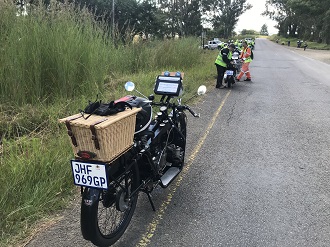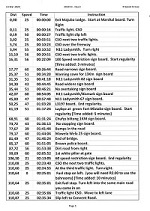1000 Kilometres on Two ABCs in the Durban-Johannesburg Rally, March 13/14, 2020.
Part 1: The Action (the interesting bit).
I arrived at Peter Gillespie’s palatial establishment feeling somewhat second-hand after the 11-hour overnight flight from Heathrow to Jo’burg, 3/4.3.20. But a couple of cold beers and the sight of our iron steeds in the palatial en-suite garage/workshop worked wonders. The pair of one-hundred year old fully-restored ABC Sopwiths, with glossy black enamel and gleaming nickel, looked very fit for our coming outing.
Our proposed schedule for the days to the event was a couple of hours each morning of machine-checking, followed by trips out to the Kruger Safari Park, a Military Museum, and the highlights of Jo’burg, etc. But closer examination of our shiny mounts very soon showed us that their beauty was less than powder-coating deep. On one, we found that the cylinders had been linered, indicating that the cast iron heads were connected to the crankcase only by a pair of razor-blade thin residual steel tubes...The other was little better, with only two main bearings instead of the designated three! So-much for our proposed schedule! In fact, the next seven days were spent, dawn till dusk, spanner-twirling and putting things as right as we could, as more problems emerged from the immaculate depths. Even a beautifully boot-polished Dunlop Cord rear tyre had to be condemned.
Fortunately, Peter had long been organising the production and gathering of many new replica or replacement components, so that duff pistons, cylinders, valves and their guides and springs etc., did not present show-stopping situations. Actual rally-preps. occupied additional time, involving the fitting of lights and ‘rally boxes’ (see below) and mirrors, etc.
A final flurry of adjustments and checks on Thursday morning, we announced ourselves fit, and the machines trailered (with a 1930 AJS for another rider) behind the family jeep. We drove to the museum railway station in Heidelberg, the appointed start of the Rally some miles to the south-east of Jo’burg, for Machine Scrutineering and collection of our papers, and bags of handouts that included Starters’ Medallions, commemorative teeshirts, tubs of gritty-custard hand-cleaner, and more. The old station was truly picturesque, complete with enormous steam loco from 1918, and coaches converted to a restaurant. Also on site was a micro-brewery that produced in particular a stout beer of great excellence! The bikes (all 109 of them) went into an original goods depot for the night. There were the usual speeches and jollification and an early-evening buffet, after which we departed for home. A great tropical storm started up, and the thunder, lightning and deluge continued all night.
At 05.30 the next morning the storm was abating, as we hit the highway back to Heidelberg, for a planned demonstration run round the township. Although the roads were dry before we got there, we were told that the demo was cancelled. Nothing for it but to stooge to 09.00, the start of the Rally. We were sent off at one minute intervals on the first leg of the event: navigation was easy, but keeping to the ever-changing speed schedules less so.

Emerging from the overnight storage shed on Friday morning.
On a steep upwards incline immediately before the lunch (and first fuel) stop, my steed went lame. Mysteriously, the LH exhaust tappet had loosened right off. This was soon corrected, and the bike missed not a single beat all afternoon.
Peter had an incident too: a solid seize-up on one cylinder after only twenty miles. But after letting it all cool off for a quarter of an hour, it restarted and ran well for the rest of the whole event! Peter’s bike was fitted with very expensive JE American forged pistons, not the industrial H***a devices in my model: food for thought here, I think.
A lot of the traffic that overtook me on the road was tender vehicles with trailers, often with failed bikes on board! And many bikes evidently required roadside adjustments, or heavier attention.
There was a wide spectrum of panoramas, and road surfaces, from extremes of unspoiled veldt and smooth tarmac, to shanty towns and potholed, compacted dirt. But generally, it was easy going.
At length we rolled into Newcastle and the Majuba Lodge and the end of the day’s run (150 miles). We submitted our loggers (see below) and got quite a lot of beer down our necks. To our Inn across the road for quick showers, and back to the Lodge for a communal feed, with some excellent S. African red wine. After that, we decided to postpone machine servicing, and headed for zizz.
Day 2, Saturday, and up at about 05.30 again (ugh). This time it was for the 06.00 Start, very soon after dawn. Hurried fettling, and off, on a longer route of 220 miles.
All went well over similar terrain to the previous day, until – again within cursing distance of the lunch stop – my velocipede croaked, as I pulled away from traffic lights. This time it was terminal. A sodding little fourpenny rocker-adjustment screw had snapped, discontinuing motion from its pushrod. Our tender vehicle carried a spare crankshaft, rear tyre and set of fork spindles, but – no rocker screws. Sadly, I helped load the bike onto its trailer, and spent the rest of the ride in the air-conditioned luxury and cold-beer-equipped cab of the towing vehicle: it could have been worse!
I appreciated this ever more, as we dropped down the escarpment from the veldt, at about 5000 ft., to the coastal plain, not a lot above sea level. The temperature and humidity increased considerably!
The Finish was in the grounds of the Shongweni equestrian club, well-protected by lofty leafy trees, a spacious pavilion and - need I say it? - a bar. Peter and the ABC cruised in on schedule, seemingly fit for more: the ABC’s rear suspension was a real bum-saver.
We spent the evening and night at the nearby majestic home of some of Peter’s relations, in an estate called The Cotswold Downs!
Next morning, after a lie-in to 06.30, we returned to the Shongweni for a DIY breakfast and the prize-giving. Prizes galore! Peter won the enormous trophy for Oldest Machine to Finish, which, to my surprise and delight, carried the revered name of the late, great Felix Burke! He won it in the 1970 event, on his Williamson outfit, I guess, passengered by Rose.
After that, we drove into Durban and onto its seafront boulevard, for a quick paddle in the Indian Ocean. And that was really the end of my D-J 2020.

Durban, with Peter and his trophies. Maybe the one I'm holding was for Best ABC.
Part 2: The Background (and nitty gritty).
This event is not for the faint-hearted, nor ill-equipped! Of the 109 intrepid starters, on pre-1936 machines, there were only 70 at the finish, 370 miles later, the next afternoon. But to digress a little…
In 1913 there was a somewhat free-for-all race from Johannesburg, up on the high veldt, to Durban, on the east coast of South Africa, by the best route that anyone could find: overgrown cart-tracks formed parts of the way, and it took them three days to get there. Anyway, it went down so well with the riders that it was repeated each year whenever possible until 1936, when the authorities of the time outlawed it as being far too dangerous, which it probably was.
Fast forward to 1970, when a Commemorative Event was inaugurated. This took the form of a Regularity Run, over a far more civilised route with one overnight stop, that again went down so well with the riders that it has been re-enacted nearly every year since. This year was its Fiftieth Anniversary (noting that most of the runs have been in the Durban-Jo’burg direction), and it was as well supported as ever.
So what it is, is a run defined by detailed route cards, divided into a large number of sections, each to be travelled at a variety of stated average speeds (see illustration). These cards are issued at the Machine Scrutineering procedure the day before the run, and are to A4 format, typically four pages long for each day. Most entrants gum these sheets nose to tail, and roll them into their Rally Boxes, which are effectively perspex-topped boxes containing the plastic rollers familiar to most VMCC rallyers. The boxes are likely to contain a second (independent) pair of rollers, which supply, ready-reckoner table style, speed/distance/time figures to cover all requirements, to the second.
To pass Scrutineering, machines are required to have the following: working front and rear lights (battery-powered LEDs are acceptable), left and right-hand mirrors, a hooter of some description, front and rear brakes, a working brake light, and then additional, independent lights front and rear (for instance, bicycle LEDs).
Way back, certain sections of the route were observed by hidden marshals, working with binoculars and ‘Rally Time’ clocks and notebooks, to register the riders’ performances, regularity-wise. But this aspect of the event has long been updated, being now managed by ‘loggers’, matchbox-sized GPS-linked data recorders, carried by each rider. They are turned on 10 minutes before each rider’s start, and are submitted at the finish of each day’s run, to be downloaded by rally officials.
If timed-to-the-second Regularity Trials are your thing, then the D-J Rally is tailored to suit like no other! Nowhere are the speed schedules difficult to keep to, but high accuracy is essential to land in the prizes. Of course, one can go just for a very different sort of ride...almost guaranteed, in the sun!
1. Getting there. A London-Jo’burg return ticket from BA, booked in January for mid-week flights, was £550.
2. Entry Fee. This was about £66, and included the Thursday evening buffet, Friday and Saturday lunches, the Friday evening buffet, and the Sunday breakfast. Included in the Scrutineering hand-out was a compulsory-wear Hi-Vis plastic jacket. At the Sunday prize-giving, there was an official photo of each rider, taken at the Start, and for the Finishers, an engraved medallion.
3. Third-party insurance for the duration of the event was about £3.
4. Accommodation, in Holiday Inn-style hotels, was about £40 per night (unshared room).
5. The hire of loggers was about £5.50.
6. A break-down service, and secure indoor bike storage on Thursday night, etc., were thrown in.
Entry into South Africa does not require a visa, and medical injections aren’t necessary.
They drive on the left and a British driving licence is accepted.
Exchange rate for the Rand is about R.18 = £1.
Jo’burg is sub-tropical, at about 26* South. March is at the beginning of their Autumn, with mostly dry weather at about a comfortable 24*C., noting that down on the coast, it would be hotter and stickier. Local time is only two hours different to ours: 10.00 am here is midday there, meaning that they get up earlier than we.
Paul Button.



